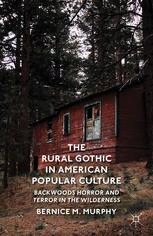
The Rural Gothic in American Popular Culture: Backwoods Horror and Terror in the Wilderness PDF
Preview The Rural Gothic in American Popular Culture: Backwoods Horror and Terror in the Wilderness
The Rural Gothic in American Popular Culture AlsobyBerniceM.Murphy THESUBURBANGOTHICINAMERICANPOPULARCULTURE SHIRLEYJACKSON:EssaysOnTheLiteraryLegacy(editor) ITCAMEFROMTHE1950s!:PopularCulture,PopularAnxieties (co-editedwithElizabethMcCarthyandDarrylJones) The Rural Gothic in American Popular Culture Backwoods Horror and Terror in the Wilderness Bernice M. Murphy TrinityCollegeDublin,Ireland ©BerniceM.Murphy2013 Softcover reprint of the hardcover 1st edition 2013 978-1-137-35371-9 Allrightsreserved.Noreproduction,copyortransmissionofthis publicationmaybemadewithoutwrittenpermission. Noportionofthispublicationmaybereproduced,copiedortransmitted savewithwrittenpermissionorinaccordancewiththeprovisionsofthe Copyright,DesignsandPatentsAct1988,orunderthetermsofanylicence permittinglimitedcopyingissuedbytheCopyrightLicensingAgency, SaffronHouse,6–10KirbyStreet,LondonEC1N8TS. Anypersonwhodoesanyunauthorizedactinrelationtothispublication maybeliabletocriminalprosecutionandcivilclaimsfordamages. Theauthorhasassertedherrighttobeidentifiedastheauthorofthiswork inaccordancewiththeCopyright,DesignsandPatentsAct1988. Firstpublished2013by PALGRAVEMACMILLAN PalgraveMacmillanintheUKisanimprintofMacmillanPublishersLimited, registeredinEngland,companynumber785998,ofHoundmills,Basingstoke, HampshireRG216XS. PalgraveMacmillanintheUSisadivisionofStMartin’sPressLLC, 175FifthAvenue,NewYork,NY10010. PalgraveMacmillanistheglobalacademicimprintoftheabovecompanies andhascompaniesandrepresentativesthroughouttheworld. Palgrave®andMacmillan®areregisteredtrademarksintheUnitedStates, theUnitedKingdom,Europeandothercountries. ISBN 978-1-349-46972-7 ISBN 978-1-137-35372-6 (eBook) DOI 10.1057/9781137353726 Thisbookisprintedonpapersuitableforrecyclingandmadefromfully managedandsustainedforestsources.Logging,pulpingandmanufacturing processesareexpectedtoconformtotheenvironmentalregulationsofthe countryoforigin. AcataloguerecordforthisbookisavailablefromtheBritishLibrary. AcatalogrecordforthisbookisavailablefromtheLibraryofCongress. Contents Acknowledgements vi Introduction:We’reNotOutoftheWoodsYet 1 1 TheCabinintheWoods:OrderversusChaos inthe‘NewWorld’ 15 2 ‘WeAreButaLittleWayintheForestYet’:TheCommunity intheWilderness 48 3 ‘GoingWindigo’:‘Civilisation’and‘Savagery’ ontheNewFrontier 92 4 BackwoodsNightmares:TheRuralPooras MonstrousOther 133 5 ‘WhyWouldn’ttheWildernessFightUs?’American Eco-HorrorandtheApocalypse 178 Notes 214 Bibliography 238 Filmography 246 Index 248 v Acknowledgements Tobegin,Iwouldliketoacknowledgethesupportmyfamilyprovided during the writing of this book. Many thanks therefore to John and Majella Murphy, my brother Eoin, my sister-in-law Emma, and my nephew Ieuan. Thankfully, they only very occasionally resemble the close-knit cannibal clans considered in Chapter 4, even though we do come from an area that epitomises a very Irish variety of ‘Rural Gothic’. The encouragement of my cousins Sinead Murphy and Dr Sheila McCartan, and of the wider family circle, is also very much appreciated. StephenMattersononceagainprovidedinsightfuladvicethroughout this project. Dara Downey’s assistance was also invaluable, particularly whilst formulating the Introduction. Elizabeth McCarthy’s notes on Chapter 4 were extremely useful, and Sorcha Ni Fhlaínn also provided helpfulfeedbackonseveralchapters. During the course of writing and researching Rural Gothic, I was for- tunateenoughtobeabletousetheclassroomasalaboratoryformany of the ideas that have found their way into this book (and some that justifiably haven’t...). The enthusiasm and interest shown by students onmy‘RuralGothic’and‘LandscapesofFear’moduleswasheartening, andourdiscussionsdefinitelyinfluencedthisbookforthebetter. General thanks and appreciation are also due to those who have recommended books and films, or otherwise provided encouragement and advice. They include Erwan Atcheson, Sarah Cleary, Brian Cliff, Helen Conrad O’Brian, Caroline Egan, John Exshaw, Moira Fowley- Doyle, Edwina Keown, Hilde Langkjær Losnegård, Jarlath Killeen, DarrylJones, Jenny McDonnell, Brian J. Showers, Brendan O’Connell, ElizabethParker, Maria ‘Fight the Power’ Parsons, and Pádraic Whyte. Thanks are also owed to Felicity Plester and Chris Penfold at Palgrave Macmillan. TheTCDArtsandSocialSciencesBenefactionFundmadeagenerous contribution towards the research costs of this book. Its assistance was of immense help. Support from the fund also enabled me to present some of my work at the 2012 Popular Culture Association Conference in Boston. On that topic, I am profoundly grateful to my colleagues Dara Downey and Miles Link for not abandoning me in small-town vi Acknowledgements vii Massachusetts when it became horribly clear that my Ahab-like quest toseePlymouthRockwouldinvolveaneight-mileroundtrip,onfoot, indecidedlyinclementweather. Finally, this book is dedicated to the memory of my cousin James McCartan,wholovedhorrorfilms.Hislossiskeenlyfelt. Introduction: We’re Not Out of the Woods Yet Thepremiseoftherecentlow-budgetindiehorrorfilmYellowBrickRoad (2010)issimple.In1940,theentirepopulationofasmalltownnamed Friar, New Hampshire, suddenly decided to walk into the wilderness. Most of the townsfolk froze to death or were torn apart by unknown perpetrators.Inthepresentday,agroupofresearchersdecidestofollow the same trail, in the hope of turning legend into ‘recorded history’. However,withinafewdays,theyfindthatdespitealloftheirequipment andexpertise,theyarebeingchangedbytheirtimeonthetrail,andnot forthebetter.Asthetaglineputsit,‘Theyweresearchingforanevilin theforest...Buttheforestfoundtheevilinthem.’ If this all sounds a little familiar, well, perhaps that is no surprise, given that the film’s premise appears to resemble that of The Blair WitchProject(1999).AlthoughYellowBrickRoaddiffersinsomeimportant respectsfromitsbetter-knownpredecessor,thehorrorinbothfilmspiv- otsonthedesperatefearoflosingoneselfinthewilderness.Thefurther thecharactersstrayfrom‘civilisation’andtowardstheintangiblesome- thingthatlurksattheheartoftheAmericanforest,thefurthertheystray from their daylight, or rational ‘original’ selves. The Blair Witch Project has protagonists who genuinely believe that ‘It’s very hard to get lost in America these days, and it’s really hard to stay lost.’ As it gradually becomescleartothemthatthisisadangerouslymisguidedassumption, theybegintoexperiencefearsthatreplicatethosefrequentlyexpressed inwhatIhavecharacterisedasthe‘RuralGothic’. One of the first intimations of trouble is a strange arrangement of rocks,ofwhichtheyremark,‘ItlookslikeanIndianburialground’–an indication of their fear of the nation’s ‘buried’ racial past. Then, their fears turn to terror of a hostile human presence: ‘Have you ever seen Deliverance?’ This sense of escalating unease gradually evolves into a 1 2 TheRuralGothicinAmericanPopularCulture morenebulousfeelingthat‘We’reobviouslynotwantedhere’andthat the forest itself is actively malevolent. When one of the trio, Josh, is kidnapped by someone (or something) unseen, and indications that something of an occult nature is afoot pile up, team-leader Heather’s prediction that ‘We’re all gonna die out here’ becomes a self-fulfilling prophecy. LiketheresearchersinYellowBrickRoad,Heatherandherfriendshave gone looking for trouble in the forest, and been horrified to find it. ThesamecouldbesaidofthetitlecharacterinNathanielHawthorne’s ‘YoungGoodmanBrown’(1835),oneofthemostinfluentialAmerican horror stories ever written.1 Hawthorne’s young Puritan insists upon enteringtheforestthatencirclesSalemVillageatnightdespitehiswife’s graveconcerns.Likethecharactersinthefilmsjustmentioned,Brown’s journeyisnorandomforayintothewilderness:hehasanappointment to keep. In observing this rendezvous, he will forever taint his rela- tionshipwithhiswife,thecommunity,and,finally,himself.Goodman Brown’smosthorrificdiscoveryofallistherealisationthatheishimself ‘the chief horror of the scene’.2 It is a realisation that we find repeated againandagainintheRuralGothic. As this book shall illustrate, American horror and Gothic narratives frequently return to the forests that confronted European settlers and explorersintheearlycolonialperiod.Itisatendencythatcanperhaps bemostaptlyexplainedbycomparisonwithexperimentsconductedin the1950swhichprovedthathumantravellershaveaconstantveering tendency.‘Theresultofuncorrectedveeringis that,onanuncorrected journey, the traveller may follow a spiral path, eventually returning to the vicinity of the origin.’3 In other words, the traveller making his or her way in a territory without easily recognisable landmarks tends to end up back where they started. As we shall see, it is no coincidence that when American authors and film-makers fantasise about the end of civilisation as they know it, they so often produce narratives which unconsciously evoke the beginnings of European settlement. In their imaginings of an American end, like the disorientated forest traveller, theyreturntowhereitallbegan. The US in the twenty-first century may be a predominately urban (and suburban) nation, but something keeps drawing writers and film-makers back to this point of initial contact, and to the cultural constructions that have sprung up around it. Perhaps this is at least partially because, as William Cronon has suggested, ‘In the wilderness, the boundaries between human and nonhuman, between natural and supernatural,havealwaysseemedlesscertainthanelsewhere.’4Itisthat
